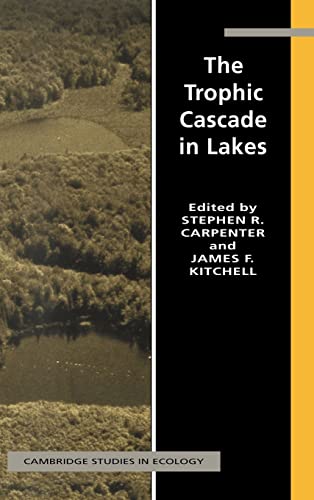Items related to The Trophic Cascade in Lakes (Cambridge Studies in...

Synopsis
Fluctuations in fish populations in lakes can cascade through food webs to alter nutrient cycling, algal biomass and primary production. Trophic cascades may interact with nutrients and physical factors to explain most of the variance in lake ecosystem process rates. In this 1993 book, a multidisciplinary research team tests this idea by manipulating whole lakes experimentally, and coordinating this with palaeolimnological studies, simulation modelling, and small-scale enclosure experiments. Consequences of predator-prey interactions, behavioural responses of fishes, diel vertical migration of zooplankton, plankton community change, primary production, nutrient cycling and microbial processes are described. Palaeolimnological techniques enable the reconstruction of trophic interactions from past decades. Prospects for analysing the interaction of food web structure and nutrient input in lakes are explored.
"synopsis" may belong to another edition of this title.
Review
"I found the book to be clearly written, and appropriate for its target audience, researchers in ecology and resource management...The breadth of approaches brought to bear in the study is extremely impressive...I recommend this book as a fine case history of a pluralistic approach to an important ecological issue." Tim Wootton, Ecology
"State-of-the-art theory and methods in a variety of ecological and aquatic disciplines are brought together and integrated. Many ecologists will be intrigued by the statistical approaches applied throughout the book...resource managers will find important and useful lessons about ecosystem management in practice." Brett Johnson, Fisheries Review
"This book is of interest to workers in ecology, aquatic ecology, resource management, and limnology." Environment International
Book Description
Experimental manipulations of whole lakes are used to test the idea that fluctuations in productivity can be driven by variations in predator populations. This 1993 book shows that population and ecosystem processes can be strongly linked. The study combines population, community and ecosystem ecology.
"About this title" may belong to another edition of this title.
FREE shipping within United Kingdom
Destination, rates & speedsSearch results for The Trophic Cascade in Lakes (Cambridge Studies in...
The Trophic Cascade in Lakes
Seller: Better World Books Ltd, Dunfermline, United Kingdom
Condition: Very Good. Ships from the UK. Former library book; may include library markings. Used book that is in excellent condition. May show signs of wear or have minor defects. Seller Inventory # 14341436-75
Quantity: 1 available
The Trophic Cascade in Lakes
Seller: Better World Books, Mishawaka, IN, U.S.A.
Condition: Good. Former library book; may include library markings. Used book that is in clean, average condition without any missing pages. Seller Inventory # 51308298-6
Quantity: 1 available
The Trophic Cascade in Lakes
Seller: PEMBERLEY NATURAL HISTORY BOOKS BA, ABA, Iver, United Kingdom
Condition: Very Good. xiv, 385, text figs. . HB. Vg in d/w. Owner's name to endpaper. . [9780521431453]. Seller Inventory # S40314
Quantity: 1 available
The Trophic Cascade in Lakes (Cambridge Studies in Ecology)
Seller: Pistil Books Online, IOBA, Seattle, WA, U.S.A.
Hard Cover. Condition: Near Fine. Dust Jacket Condition: Near Fine. A clean, unmarked book with a tight binding. Full black cloth boards. Previous owner's stamp blacked out with black ink on front free endpaper. 386 pages. Seller Inventory # 157178
Quantity: 1 available
The Trophic Cascade in Lakes (Cambridge Studies in Ecology)
Seller: Ria Christie Collections, Uxbridge, United Kingdom
Condition: New. In. Seller Inventory # ria9780521431453_new
Quantity: Over 20 available
The Trophic Cascade in Lakes
Seller: THE SAINT BOOKSTORE, Southport, United Kingdom
Hardback. Condition: New. This item is printed on demand. New copy - Usually dispatched within 5-9 working days 730. Seller Inventory # C9780521431453
Quantity: Over 20 available
The Trophic Cascade in Lakes (Hardcover)
Seller: CitiRetail, Stevenage, United Kingdom
Hardcover. Condition: new. Hardcover. Fluctuations in fish populations in lakes can cascade through food webs to alter nutrient cycling, algal biomass and primary production. Trophic cascades may interact with nutrients and physical factors to explain most of the variance in lake ecosystem process rates. In this book, a multidisciplinary research team tests this idea by manipulating whole lakes experimentally, and coordinating this with palaeolimnological studies, simulation modelling, and small-scale enclosure experiments. Consequences of predator-prey interactions, behavioural responses of fishes, diel vertical migration of zooplankton, plankton community change, primary production, nutrient cycling and microbial processes are described. Palaeolimnological techniques enable the reconstruction of trophic interactions from past decades. Prospects for analysing the interaction of food web structure and nutrient input in lakes are explored. Experimental manipulations of whole lakes are used to test the idea that fluctuations in productivity can be driven by variations in predator populations. This 1993 book shows that population and ecosystem processes can be strongly linked. The study combines population, community and ecosystem ecology. Shipping may be from our UK warehouse or from our Australian or US warehouses, depending on stock availability. Seller Inventory # 9780521431453
Quantity: 1 available
The Trophic Cascade in Lakes (Cambridge Studies in Ecology)
Seller: California Books, Miami, FL, U.S.A.
Condition: New. Seller Inventory # I-9780521431453
Quantity: Over 20 available
The Trophic Cascade in Lakes
Seller: Revaluation Books, Exeter, United Kingdom
Hardcover. Condition: Brand New. 400 pages. 9.50x6.50x1.00 inches. In Stock. This item is printed on demand. Seller Inventory # __052143145X
Quantity: 1 available
The Trophic Cascade in Lakes (Cambridge Studies in Ecology)
Seller: BennettBooksLtd, North Las Vegas, NV, U.S.A.
hardcover. Condition: New. In shrink wrap. Looks like an interesting title! Seller Inventory # Q-052143145X
Quantity: 1 available

